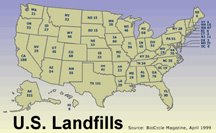Countywide: years for fix - Company maintains that there's no fire at controversial landfill
The Times-Reporter
COLUMBUS - Maintaining its view that there are no underground fires at the Countywide landfill, Republic Services of Ohio said in its Fire Suppression Plan to the Ohio EPA that fixing problems there will take years. Critics accused the company of wanting to maintain the status quo to the detriment of landfill neighbors.
In March, the Ohio Environmental Protection Agency ordered the com-pany to submit a plan by Tuesday to deal with the fires within the 258-acre Countywide Recycling & Disposal Facility.
In the plan, the company said excavating the 88 acres where the problems have occurred would take 10 years to complete, “be prohibitively expensive,” “create significant health and safety concerns for site workers” and “create significant air emissions resulting in overwhelming odor impacts for the community.”
Injecting various chemicals into the ground to stop what the company calls chemical reactions “may have no benefit at all or could even be detrimental” because it might expand the problems.
Instead, the company wants to monitor and expand the landfill gas collection system, replace damaged wells, evaluate the cap it put over 30 acres and refine the odor neutralizing system. It said it would cap permanently the entire 88-acre section but doing so would take three to six years. The report contends the aluminum reaction has a “limited life” that has reached its peak and will end “in approximately two years.”
“So folks have to put up with it for two years,” said Tuscarawas County Commissioner Kerry Metzger. “That option sure sounds like the status quo to me. It’s back in the EPA’s lap.”
“That plan sounds pretty minimal to me,” said Richard C. Sahli, an attorney for Club 3000, a citizens group opposed to the landfill.
Melissa Fazekas, the EPA’s deputy director of communications, said the agency is reviewing the 92-page plan and would have no comment about it.
“Most of our own experts will look at it,” she said, including Todd Thalhamer of the California EPA, who said in February that two fires burning underground were causing the odors that sparked numerous complaints from area residents.
Earlier this year the company estimated it will cost $22 million on top of the $4 million it spent last year trying to solve the stench coming from the landfill, which accepts 6,000 tons of waste per day. Republic said the EPA’s order to close the 88 acres will cost it $3.3 million per year. The EPA also fined Republic $1 million.
“We believe the aluminum waste is undergoing a chemical reaction and that it is not on fire,” said Republic’s report, which was developed by SCS Engineers of Cincinnati. “We further believe that the municipal solid waste is not burning or undergoing a smoldering fire.”
“I think it’s incredible that they’re still denying the existence of the fire,” Sahli said. “Any independent thinking person would have concluded a fire there over a year ago. To claim otherwise is corporate spin.”
The reaction was caused when liquid waste came in contact with aluminum waste called dross, which in turn caused intense heat and odors.
Republic’s plan said the company’s efforts to suppress the reaction and contain odors over the past year and half have worked. It said “odor detections off-site and the magnitude of those detections have decreased dramatically.”
Metzger suspects area residents are resigned to the landfill’s problems and aren’t reporting their complaints as often as before. Still, Metzger said he was told last month the EPA is detecting unacceptable odors levels.
“It’s a little disconcerting that it would take three to six years to cap it,” he said. “The status quo is an option the EPA needs to take a long, hard look at. Cost should not even be a consideration. Whatever it takes to put the fire out – the timeliness and effectiveness of that option should be the priority.”
Metzger also said Tuscarawas County commissioners are concerned about the deterioration of the landfill’s liner and possible contamination of area aquifers.
“The fires destroyed the liner,” Sahli said. “The only question is how much of the liner was destroyed. The longer the fire smolders the more it increases the danger to ground water.”
Republic maintains the liner has not been damaged.
Sahli said allowing the company to proceed “so slowly toward resolving the fire may save them money but only continue to harm the landfill’s integrity.”
On the Web:
www.epa.state.oh.us/pic/countywide.html
EPA receives landfill plan for fire safety
Fire suppression plan submitted for landfill













